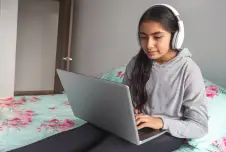Parenting a child with additional learning, attention, social-emotional, or behavioral needs has never been easy—and it’s not exactly getting easier. Distance learning and hybrid learning have created a whole new layer of challenge for the approximately 7.1 million children who receive special education services in American schools.
It’s impossible to perfectly replicate at home the individualized support and attention that students with special education received in school buildings, so it’s no wonder that many parents are struggling to make it work.
As a school psychologist (and mom of two), it breaks my heart to hear stories of parents of kids with special needs who have all but given up. One friend of mine told me that she was going though old photos of her family and started crying because now she feels like all she does is fight with her child with ADHD to focus on Zoom. As I described in the article for educators Greater Good published yesterday, another parent in my daughter’s classroom Zoom meeting propped up a sign for her son that read, “I can’t learn like this. I have special needs.”
To complicate matters, not every parent has the kind of job where they can sit with their child all day—they may need to leave older children at home to go to work or have to tend to their own work tasks during the day. Many parents are also emotionally drained right now. They have their own struggles with anxiety, depression, or focusing under stress, and thus have less energy for coping with their children’s struggles too.
So, what can parents of children with special needs in these most challenging of circumstances realistically do to bridge the gaps in support and reduce their own stress?
Here are the three most common challenges I have been seeing for children with special needs—and what parents can do when they see these challenges at home.
“My child cannot pay attention on Zoom”
“Zoom fatigue” is real, not just for kids, but for adults, too. Having to maintain constant eye contact, avoid the temptations of other tabs in a browser, and process visual information all day is a real strain on attention.
There is also a significant lack of real-time feedback for students. Whereas in the classroom, the teacher would be able to give individualized nonverbal cues, such as eye contact, a smile, a thumbs up, or a gentle hand on a shoulder to return children to focus, this is challenging over computers. If you see your child struggling, here are some tips to support their attention:
- If you can’t sit next to your child while they are on Zoom all day, periodically check in and give encouragement, praise, and nonverbal support (a simple smile from across the room will do!). Try to “catch them” being focused and give acknowledgement.
- If you can’t monitor your child during the day, ask the teacher to report back to you in a quick email or text when your child has a good day with focus, so that you can praise your child later.
- Observe how long your child is typically able to focus on Zoom (10 minutes? 30 minutes? An hour?) and provide this feedback to your school team. If your child is really not able to focus for the expected length of “synchronous” time (time online with the teacher live), advocate for “asynchronous” learning time (on their own, off Zoom). This may look like being given a special hands-on project or modified work that they can do with a parent, off Zoom, and then share with the teacher later for feedback.
- Allow movement and frequent breaks. Your child may focus better with a wiggle cushion, fidget toy, or while doodling on a whiteboard. They may need to use Bluetooth earbuds so they can listen and move about. If your child needs to turn off the video to take a refocusing break, make sure that they have collaborated with their teacher about how they access this break (e.g., send a private message in chat, raise their hand virtually, etc.).
- During actual breaks, make sure your child picks an activity where they can move their body! Gonoodle.com has fun dance breaks and movement games that are only a few minutes long and can be done on a break.
- Build in mindfulness activities as both a proactive and an “in the moment” strategy to reboot focus. Mindfulness has been shown to improve attention, concentration and mood.
“My child is having big feelings, meltdowns, or behavioral challenges”

Children in general profit from predictability and structure, which is challenging with the ever-changing landscape of schools moving to distance learning or hybrid learning. Anxiety and stress were already on the rise in children before the pandemic, so it’s safe to say that they are even higher now.
When children are under stress, they may be extra sensitive or reactive. This can look like seemingly small events triggering big reactions. They may show withdrawal and sadness, or anger and irritability. If your child struggled with emotional and behavioral self-control before the pandemic, these feelings and behaviors might be magnified now. Here are tips for parents whose kids are facing these challenges:
- Remember that behavior is often the “tip of the iceberg.” What could be below the waterline are unmet needs and lagging skills that need to be taught, like coping and emotional self-control skills. It’s important to remember that your child is not giving you a hard time when they act out or overreact, they are having a hard time coping. Get curious about what they are trying to communicate through their behavior (e.g., “I’m sad, I’m worried, I am over- or under-stimulated with my sensory needs, I am hungry/tired,” etc.). Then work to teaching strategies to cope with the underlying challenges.
- Research on resilience shows that in stressful times, having a positive relationship with an adult has a buffering effect. In other words, your relationship with your child protects them from stress. A helpful mantra I’ve been using since the beginning of the pandemic, when we all became overnight homeschooling parents, is this one: “Connection is protection.”
- When your child is having emotional or behavioral challenges, lean in with empathy before problem solving (e.g., “It makes sense why this is hard for you” and “I see this is upsetting and I’m here to work through it with you.”) No one can problem-solve when stressed anyway, so bring down the stress first with empathy and connection.
- Ask your child’s school psychologist or school counselor for virtual push-in support on Zoom. These mental-health and learning support professionals can do check-ins, social-emotional lessons, and provide individual or small group support to boost coping skills.
“My child is disengaged or has given up on assignments”
Learning is not a place—it’s a relationship between student and teacher. When you see disengagement from learning and assignments, it’s worth thinking about how to nurture the teacher-student relationship. Even a quick Zoom check-in with a teacher during a break can fuel connection. And just like in the physical classroom, students who feel connected to their teachers are more engaged in the learning process.
As a parent, it’s also important that you feel connected and heard by your child’s learning support team. It’s hard for teachers and school staff to understand the behind-the-scenes challenges at home without you looping them in. You can request a conference with school to share your observations about what is working and what isn’t as a jumping-off point for problem solving. Here are a few strategies for increasing your child’s engagement in learning at home and collaborating with the school:
- Collaborate with the teacher to make sure the academic work is at the “Goldilocks Level” of difficulty—not too easy or mundane, but not too hard or complex for them.
- Advocate for increasing the amount of one-on-one or small group breakouts online for individualized support. Remember that connection with teachers fuels engagement, and, yes, this can be done online.
- If your school is working toward a hybrid model and you are comfortable with your child returning to school for short time periods, ask your school if this is an option for your child to receive more individualized support.
- When it comes to academics, strive for quality over quantity. If your child can demonstrate understanding with five math problems, then they may not need to do all 10 assigned. Collaborate with the teacher on modifying the volume, but not complexity of the work.
- You can also inquire if there are options for modified assignments that meet the same learning target (e.g., an oral report instead of a written report, a project that shows understanding of a science concept instead of reading about it in a textbook). It’s not about reducing the academic rigor, it’s about helping your child continue to access the curriculum right now in these unusual circumstances.
The most important thing to remember is that you don’t have to figure this out alone. Your child’s teacher and support staff at the school are part of the team and want to help. There may not be a perfect solution right now. We need to give each other grace and do the best we can under the circumstances. This too shall pass. It is my sincere hope that when all this is behind us, our children will remember not just the challenges they had, but the support we wrapped around them, too.









Comments